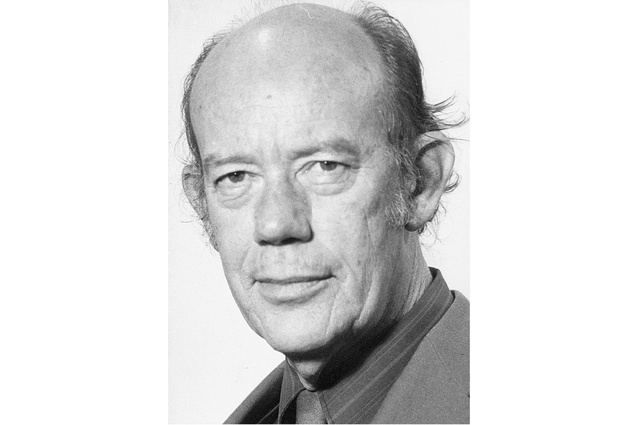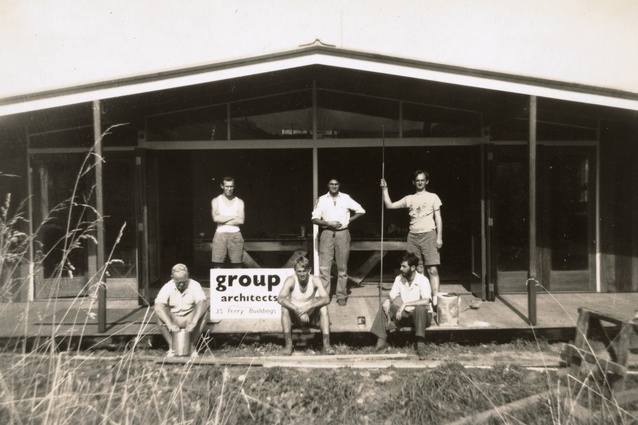Obituary: Professor Emeritus Allan Arthur Wild
Dr Julia Gatley pays tribute to NZIA Gold Medal-winning architect Allan Wild, a member of Group Architects, a Wellington City Council architect and a University of Auckland academic.
Allan Arthur Wild was both anawarded practitioner and a long-serving academic leader. In recognition of his contributions to practice, he was one of 12 individuals who received NZIA Gold Medals in 2001 as members of the Architectural Group.
The University of Auckland had already recognised his long and distinguished service in academia, appointing him Professor Emeritus upon his retirement from the university in 1993. He took up the positions of Professor of Architecture, Head of the School of Architecture and Dean of the Faculty of Architecture in 1969. He served as Head until 1990 and as Dean until early 1993. To have served 24 years at the helm is an impressive achievement.
Wild was born in Feilding, where both of his parents were teachers. His own schooling was in Lower Hutt, following his father’s appointment as an Inspector of Technical Schools there. At Hutt Valley High School, he was head prefect and dux of his year, and earned a university scholarship.
He worked in the Government Architect’s Office for the summer of 1944–1945, before moving to Auckland to study architecture at what was then Auckland University College. His cohort was a lively one, and Wild was among those who formed the Architectural Group in their second year, inspired by classmate Bill Wilson’s knowledge, energy and ideas. They wrote a constitution and a manifesto and published the first issue of a magazine, Planning.
After the fourth year of his five-year Bachelor of Architecture (BArch) degree, Wild returned to Wellington to complete his thesis year there but, upon learning of the Architectural Group’s metamorphosis into the Group Construction Company and its initiative, with parental backing, to design and build a modern house at Hauraki on Auckland’s North Shore, he determined to rejoin the collective.
The timing was memorable. He married Patricia Drawbridge in May 1949 and, after honeymooning at the Chateau Tongariro, they continued north to Auckland, where he joined his friends on site. Together, they built the Group’s First House. The Second House and Rotherham House followed in 1950–1951, by which time media attention had generated clients and the Group morphed again, this time into Group Architects.

Wild remained with the Group until September 1952, when he returned to Wellington to take up an architectural position at the Wellington City Council, where he was soon promoted to Architect-in-Charge. He then formed a partnership with Anthony Treadwell (1956–1958), was an associate with Porter & Martin (1959–1964) and became director of Williams Development Holdings’ architectural division (1964–1969), for which he designed apartment buildings, including the much-admired Jellicoe Towers on The Terrace (1964–1965).
During his years in Wellington, he was actively involved with the Architectural Centre, including serving a term as president and teaching evening classes in architecture through the Wellington Technical College. He was also active in the Wellington Branch of the NZIA, including a term as chair. He was made a Fellow of the Institute in 1968.
When Charles Light retired from the positions of Head and Dean of Architecture at the university of Auckland in 1968, Wild hoped that the University would appoint Bill Wilson as Light’s successor. Wilson’s premature death that year prevented this and, ultimately, Wild applied for the position himself, taking it up, as noted, in 1969.
The appointment of a practitioner to the role was intended to foster closer relations between the School and the profession. Thus, he represented the university on the NZIA Council and its Education Committee, and became a Ministry of Education nominee on the Architects Education and Registration Board. He was also involved with the Commonwealth Association of Architects and the Commonwealth Board of Architectural Education.
During his tenure at the university, Wild often reflected upon changes to architectural education in the pages of the NZIA Journal, including the introduction of accreditation visits (then called Joint Visiting Boards) in 1971. In 1972, he withstood the challenge provided by a student strike, leading to the rewriting of the BArch and the introduction of more elective courses. In the mid-1970s, staff established the Brick, Steel and Timber sub-schools as vertical studios in which students from different year groups were taught together.
For much of the 1970s and into the early 1980s, Wild worked closely with Kingston Reynolds Thom & Allardice (KRTA) on the design and construction of the current Architecture and Planning Building and its low-rise administrative wing (now known as the Conference Centre), opened in 1978 and 1982 respectively. He was proud of the studio spaces in particular and, in 1991, reflected that, “There is no school of architecture in the world with better accommodation”.
Wild’s last 10 years at the university coincided with an economic boom and the share market crash. The Faculty was influenced by the rise of postmodernism in architecture and planning, increasing diversity among staff and students, the beginnings of the digital age and emerging interests in sustainable design. A bad review in 1986 led to another restructuring of the BArch syllabus and the setting up of Architecture, Property and Planning as three separate departments, and put an end to what were, by then, remnants of the vertical teaching model.
Retirement at age 65 was the expected norm in the early 1990s. Wild stayed at the university until just before his 66th birthday. He then returned to practice under the name Architects Wild.
Among other projects, he worked on Abbeyfield housing for the elderly in Auckland, in collaboration with Marilyn Reynolds. He also continued to engage with architecture through organisations such as the Architectural Centre and DOCOMOMO New Zealand, and with the arts more generally, notably as Deputy Chair and Chair of the Lopdell House Gallery Committee.
Throughout his life, Wild maintained a keen interest in music. He played the clarinet and the saxophone and sang in choirs. Auckland students from the 1970s and 1980s recall him playing the clarinet at School of Architecture barbecues.
And he liked to stay fit, taking part in athletics when he was young, playing tennis and squash for many years and maintaining a gym membership well into his retirement.
Wild was an active documenter of his own career, recognising his place in the history of New Zealand architecture. He was interviewed about the Group for the AAA Bulletin in 1977, penned various autobiographical papers, such as ‘Post-War Generation’ and ‘A Tale of Two Cities’, which tracked his memories of the Group in Auckland and the Centre in Wellington, and donated an extensive personal collection of papers and drawings to the University of Auckland’s Architecture Archive, most of which awaits detailed analysis.
All of this shows the importance he attached to his time with the Group in particular. He was its last surviving member. His achievements extend to the 24 years he served as Dean of Architecture at the University of Auckland, where his practice background was an essential component of his direction and leadership, even as his tenure coincided with a period of unprecedented individualism and freedom – in life and in the School.
Wild is survived by his and Patricia’s seven children, 13 grandchildren and two great-grandchildren. His three sons – Max, Bruce and Adam – are all architects, while daughter Jane Wild is a former Faculty Librarian at the university and grandson Sebastian Clarke is the most recent family member to graduate from the School of Architecture and Planning, in urban planning.
Wild died a few days before his 92nd birthday. Longevity was another impressive achievement.











